
Researchers have developed a technique to edit out bits of mitochondrial DNA that could otherwise pass on incurable diseases, a study in mice shows. Salk Institute scientists used specifically engineered molecular scissors to snip out mutations in embryos, leaving healthy DNA intact. They hope it could one day be used to prevent human mitochondrial diseases.
But experts say though it is a "technical masterpiece", it raises ethical and scientific challenges. Mitochondria are tiny powerhouses found inside nearly every cell in the body, generating energy necessary for essential functions.
They carry their own DNA, which is passed on from mothers to their children. Unlike DNA found in the nuclei of cells, this does not affect characteristics such as appearance. But if inherited mitochondrial DNA is defective, children can have life-limiting conditions involving muscles weakness and blindness.
Reporting in the journal Cell, scientists tested molecular scissors on mice with two different types of mitochondrial DNA (mtDNA). They were able to recognise and cut out disease-causing mtDNA in mouse embryos. And the resulting offspring were healthy.
